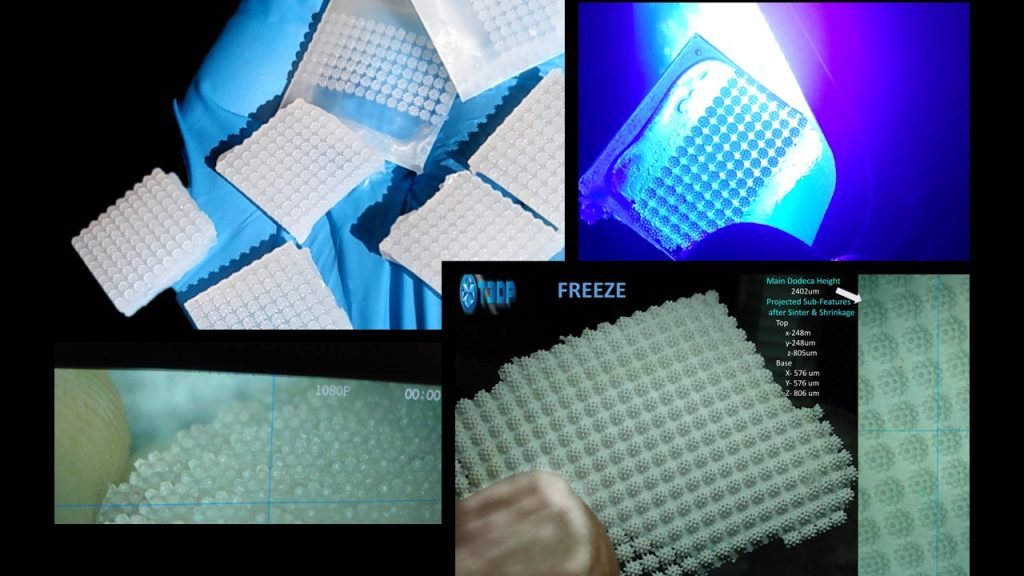Time is running out! Nominate now for the 3D Printing Industry Awards 2023.
California-based 3D printing technology company T3DP has developed a new 3D printing material combining a proprietary blend of recycled glass waste and Tethon 3D’s Genesis development resin. This innovation enables volumetric 3D printing for micro 3D solar and semiconductor applications.
3D Printing Industry recently asked T3DP Founder Daniel Clarke a few questions over email to learn more about this new technology, and its long-term benefits for additive manufacturing.
“With our process we can print the large molds from a UV curable polymer resin with ultra-smooth surfaces, cast the metal at room temperature, and then burn out the binder resin which will leave ultra-smooth metals and other materials with an RA surface finish of 1 µm and below in some cases,” explained Clarke.
T3DP’s new technology was Inspired by the development of “Ultrafast High-Temperature Sintering” (UHS) by researchers at the University of Maryland, which reportedly reduces sintering times to less than 10 seconds.
Sustainable semiconductor and solar cell production
Central to T3DP’s new technology is the blending of glass waste with Tethon 3D’s resin to create a novel material with “exceptional properties.” According to T3DP, this combination allows for next-generation volumetric 3D printing and molding of photopolymers. This enables the production of micro 3D solar cells/modules and advanced semiconductor glass substrates, where microchips and memory can be placed on the glass.
Traditional 3D printing techniques used for semiconductor applications generally rely on resource-intensive and wasteful processes. T3DP’s new method is said to tackle these challenges head-on, offering a sustainable alternative that enhances performance and reduces the carbon footprint of the manufacturing process.
“This innovation has the power to revolutionize not only the 3D printing industry but also materials research as a whole,” commented Clarke. “T3DP’s fusion of recycled glass and resin is a remarkable step towards sustainable, high-performance manufacturing.”

Volumetric 3D printing and high-speed sintering
During the manufacturing process, T3DP leverages linear volumetric 3D printing to produce small sections of ultra-smooth molds, which are then stitched together to make a larger mold. Here, the recycled glass waste is mixed with Tethon’s Genesis development resin, with the glass then molded as a polymer.
According to Clarke, the volumetric 3D printing process can take seconds to minutes to complete, with the molding process taking 10-20 seconds for large area substrates measuring 6” x 6”.
The volumetric 3D printed ‘green parts’ are then sintered using the UHS technology from the University of Maryland. This novel sintering process combines radiant and contact heat to achieve rapid and uniform heating of the material up to 3000℃. Sintering is reportedly completed in under 10 seconds, more than 1000 times faster than conventional furnace sintering. This high-speed sintering technology is being commercialized by University of Maryland spinoff HighT-Tech.

Optimizing semiconductor and solar cell production
When manufacturing semiconductors with this new technology, T3DP uses fused silica to create 3D glass interposes. This bypasses the need for conventional electronics 3D printing processes, including direct writing, etching, and lithography.
“These are complex microstructures,” explained Clarke. “We bypass Lithography, (Direct Writing for Interconnect Lines), and Reactive Ion Etching by just molding the whole structure in one piece for 3D Solar and Semiconductor Glass Substrates.”
According to Clarke, this process results in a computing power increase of more than 8 times, with more chips and memory able to be “crammed into a smaller footprint”, resulting in 50% energy savings. Clarke added that T3DP has “a special proprietary mix that makes the glass 10x stronger, making it resistant to fracture.”
Additionally, T3DP’s new technology is said to optimize the production of micro 3D cells/modules.
These components are said to offer year-round reliability, and include 3D surfaces capable of capturing more sunlight from 7 am to 7 pm. Moreover, Clarke claims that T3DP 3D printed solar cells/modules offer 15-100% more energy in the same ground area while boosting power by 39% in hot regions. Clarke also stated that micro 3D solar cell substrates cannot be made through conventional glass manufacturing methods.

The future of T3DP’s technology
According to Clarke, this new technology possesses significant potential for the 3D printing industry. “Our molding is material agnostic. Currently we can only do ceramic and glass,” explained Clarke. “Bucktown Polymers is developing a new casting resin which will make our process material agonistic to work with almost any material, as its a chemical curing 3D printing resin instead of photocuring.”
Clarke also highlighted the advantages of T3DP’s new process over that of electric-car manufacturer Tesla, which is using large sand molds to giga cast their car chassis.
“With our process we can print the large molds from a UV curable polymer resin with ultra-smooth surfaces, cast the metal at room temperature, and then burn out the binder resin which will leave ultra-smooth metals and other materials with an RA surface finish of 1 µm and below in some cases.”
In terms of the commercialization, Clarke claims that T3DP is at technology readiness level 7. In other words, prototypes of the company’s recycled glass waste and Tethon resin have been successfully demonstrated in an operational environment.
Looking to the future, Clarke is confident of a swift path to market, “[We] should have the molding commercialized in less than 12 months.” Clarke also highlighted that volumetric 3D printer developer Xolo is commercializing T3DP’s volumetric 3D printing technology in Europe, “but will have to license the IP (intellectual property) once they sell in the USA.”
Additionally, Clarke stated that the process for producing the 3D solar components “should be commercialized in 18 months, maybe sooner.”
Glass 3D printing
Glass-based 3D printing is nothing new. Earlier this year it was announced that Austrian ceramic 3D printing company Lithoz had partnered with glass manufacturer Glassomer to launch LithaGlass, a high-performance fused silica glass.
This material is optimized for Lithoz’s Lithography-based Ceramic Manufacturing (LCM) technology. The company claims that the composite slurry, which has a quartz glass base, will have a significant impact on the field of ceramics 3D printing.
Elsewhere, researchers at the US Department of Defense-backed MIT Lincoln Laboratory developed a low-temperature approach to 3D printing glass objects last year. Unlike conventional glass 3D printing and post-processing, which involves exposing parts to temperatures of 1,000℃ or more, this process involves layering a custom, highly-filled ink, that’s curable at 250°C.
“We envision this versatile materials platform, when combined with multi-material additive manufacturing, will enable the fabrication of a wide variety of robust microsystems,” the researchers explained in their paper.
Subscribe to the 3D Printing Industry newsletter to keep up to date with the latest 3D printing news. You can also follow us on Twitter, like our Facebook page, and subscribe to the 3D Printing Industry Youtube channel to access more exclusive content.
Are you interested in working in the additive manufacturing industry? Visit 3D Printing Jobs to view a selection of available roles and kickstart your career.
Featured image shows micro 3D solar cell substrates in glass, and Yitrria Stabilized Zirconia 3mol% (bottom right). Image via T3DP.


